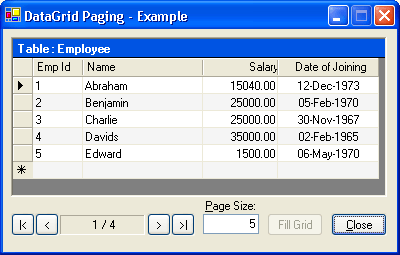
Introduction
This is an example of Windows Forms DataGrid paging using C#. I have used a Microsoft SQL Server 2000 database in the demo.
Using the code
Create a table:
CREATE TABLE tblEmp (E_ID int PRIMARY KEY, E_Name varchar(60),
E_Salary money, E_DOJ datetime)
GO
In this example, the loadPage() method fetches only the required page data from the table using the following Select statement.
strSql = "SELECT TOP " + this.mintPageSize +
" * FROM tblEmp WHERE E_Id NOT IN " +
"(SELECT TOP " + intSkip + " E_Id FROM tblEmp)";
Public variables:
protected SqlConnection mcnSample;
private int mintTotalRecords = 0;
private int mintPageSize = 0;
private int mintPageCount = 0;
private int mintCurrentPage = 1;
protected const string CONNECTION_STRING =
"Server=localhost;UID=sa;PWD=;Database=Sample";
The fillGrid() method:
private void fillGrid()
{
this.mintPageSize = int.Parse(this.tbPageSize.Text);
this.mintTotalRecords = getCount();
this.mintPageCount = this.mintTotalRecords / this.mintPageSize;
if (this.mintTotalRecords % this.mintPageSize > 0)
this.mintPageCount++;
this.mintCurrentPage = 0;
loadPage();
}
The getCount() method: this method gets the record count much faster than the SELECT COUNT(*) statement does.
private int getCount()
{
string strSql = "SELECT Rows FROM SYSINDEXES " +
"WHERE Id = OBJECT_ID('tblEmp') AND IndId < 2";
int intCount = 0;
SqlCommand cmd = this.mcnSample.CreateCommand();
cmd.CommandText = strSql;
intCount = (int) cmd.ExecuteScalar();
cmd.Dispose();
return intCount;
}
The loadPage() method:
private void loadPage()
{
string strSql = "";
int intSkip = 0;
intSkip = (this.mintCurrentPage * this.mintPageSize);
strSql = "SELECT TOP " + this.mintPageSize +
" * FROM tblEmp WHERE E_Id NOT IN " +
"(SELECT TOP " + intSkip + " E_Id FROM tblEmp)";
SqlCommand cmd = this.mcnSample.CreateCommand();
cmd.CommandText = strSql;
SqlDataAdapter da = new SqlDataAdapter(cmd);
DataSet ds = new DataSet();
da.Fill(ds, "tblEmp");
this.dgEmp.DataSource = ds.Tables["tblEmp"].DefaultView;
this.lblStatus.Text = (this.mintCurrentPage + 1).ToString() +
" / " + this.mintPageCount.ToString();
cmd.Dispose();
da.Dispose();
ds.Dispose();
}
Here is how the page navigation is implemented:
private void goFirst()
{
this.mintCurrentPage = 0;
loadPage();
}
private void goPrevious()
{
if (this.mintCurrentPage == this.mintPageCount)
this.mintCurrentPage = this.mintPageCount - 1;
this.mintCurrentPage--;
if (this.mintCurrentPage < 1)
this.mintCurrentPage = 0;
loadPage();
}
private void goNext()
{
this.mintCurrentPage++;
if (this.mintCurrentPage > (this.mintPageCount - 1))
this.mintCurrentPage = this.mintPageCount - 1;
loadPage();
}
private void goLast()
{
this.mintCurrentPage = this.mintPageCount - 1;
loadPage();
}
History
- Released on November 9th 2006.
